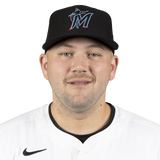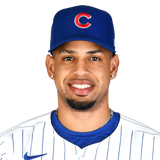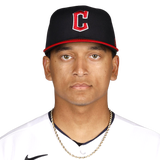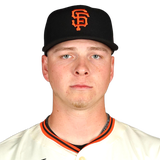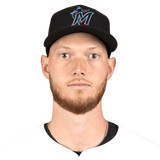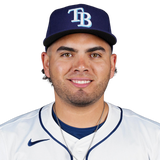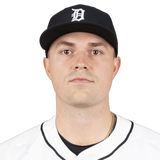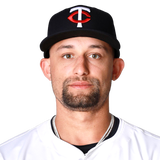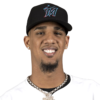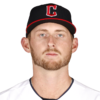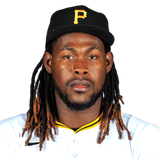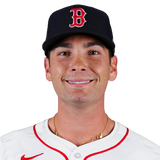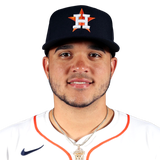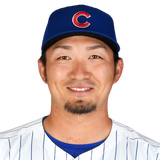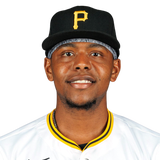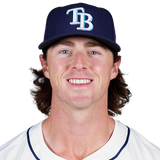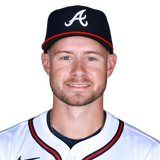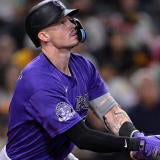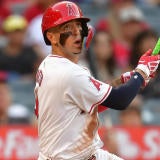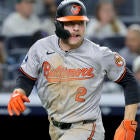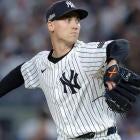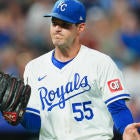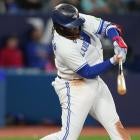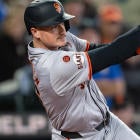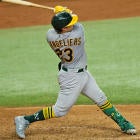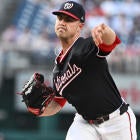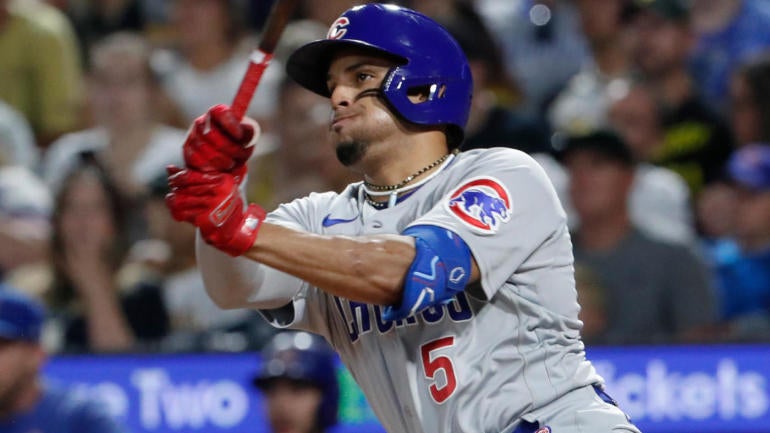
When I call a player a "sleeper," you have a pretty good idea what I mean. When I call a player a "breakout" ... well, you can probably guess what that means, too.
In short, I like him. I like all the players featured here just like I like all the players featured in my Sleepers 2.0. The distinction isn't that important. It's mostly just to provide me with another opportunity to write about players I like.
- Sleepers 2.0: Scott | Chris | Frank
- Breakouts 2.0: Scott | Chris | Frank
- Busts 2.0: Scott | Chris | Frank
But if I were to make the distinction, it would be this: The emphasis for sleepers is cost while the emphasis for breakouts is growth. Could a sleeper also be on the verge of improving his game? Sure. Could a breakout also be a bargain in drafts? Ideally, yes. So you see the room for crossover between the two designations and why it hardly seems worth making the distinction.
With that said, here are some more players I like, beginning with the new additions to Breakouts 2.0 and continuing with the holdovers from Breakouts 1.0.
THE NEWCOMERS
Jake Burger, 3B, Marlins
| ||||||||||||
FantasyPros ADP: 167.4
Burger might seem like an odd choice for a breakout pick seeing as he's coming off the season that put him on the map in Fantasy. But I'm suggesting his best is yet to come.
What stands out most for Burger is his power. Few hitters impact the ball like he does, and in fact, only five -- Ronald Acuna, Giancarlo Stanton, Elly De La Cruz, Shohei Ohtani and Matt Olson -- hit a ball harder than he did last year. That sort of elite company gives you little reason to doubt Burger's 34 home runs, a number he reached despite not becoming a full-time player until June. His ability to connect with the ball in the first place, however, was a real problem with the White Sox, which is why he had trouble finding regular playing time there, ultimately being dealt to the Marlins at the trade deadline.
That's when everything changed for Burger. His strikeout rate went from 31.6 percent with his old team to 21.7 percent with his new one. Likewise, his batting average went from .214 to .303. It wasn't just by happenstance either. He made a deliberate effort to tone down his swing, recognizing that his natural strength made it so he didn't have to sell out for power. And his power remained intact. In fact, of his 17 hardest-hit balls last year, 11 came with the Marlins.
That's not to say I'm expecting a 21.7 percent strikeout rate or .303 batting average for an entire season, but it is to say that Burger's full-season numbers undersell the improvements he made over the course of 2023. Where you see a .250-hitting, 30-homer guy, I see a .275-hitting, 40-homer guy. I'm thinking Burger may deliver better numbers than Nolan Arenado even though he's drafted, on average, almost 100 picks later.
Christopher Morel, OF, Cubs
| ||||||||||||
FantasyPros ADP: 194.0
I didn't give Morel so much as a passing glance in Breakouts 1.0 because I didn't see the path to playing time back then. The Cubs had ample alternatives in the outfield, even before bringing Cody Bellinger back into the fold, and didn't seem to like Morel's defense out there anyway, giving him most of his at-bats at DH last year. If they weren't motivated to play him, then why should I be motivated to draft him?
But there was a possibility I hadn't considered: third base. "I'd like to see him at third base," manager Craig Counsell said at the start of spring training. "Look, Christopher's done so much with the bat that it's our job to figure out the best way to deploy him, right?"
And Counsell has proceeded to play him there. Morel isn't totally new to third base, but it's a move up the defensive spectrum for a player who already didn't pass muster defensively. By pure athleticism, he's equipped to handle most any position, and so the hope is that by concentrating on one, things will finally click for him. Or maybe the Cubs have gotten so little production from the hot corner in recent years, having mostly used Patrick Wisdom and Nick Madrigal there, that they figure they have nothing to lose by trying Morel.
The broader takeaway is that Morel's bat has the Cubs bending over backward for him, which makes sense with even just a surface-level analysis of the numbers. Project his 26 homers and six steals last year over a full-season workload, and you get something like 40 homers and 10 steals. I'll call it 35-homer, 15-steal potential given Morel's 82nd percentile sprint speed. He also impacts the ball like an elite slugger, delivering a 91st percentile average exit velocity and 88th percentile max exit velocity last year, which is enough to overcome his high strikeout rate. He won't be a great source of batting average and has been known to fall into lengthy slumps, but if the Cubs stick with Morel, couldn't his final numbers be something like Adolis Garcia's, only 150 picks later? It doesn't seem far-fetched to me.
Bo Naylor, C, Guardians
| ||||||||||||
FantasyPros ADP: 239.8
Among second-year breakouts candidates at catcher, Yainer Diaz, Francisco Alvarez and Logan O'Hoppe take up most of the oxygen, with Naylor lagging behind in terms of ADP. But there's a legitimate chance he's the most impactful of the bunch. For however ordinary his rookie numbers may look -- and they're not half bad, really -- remember that he got off to a dismal start. What saved him was a stark turnaround over his final 28 games in which he hit .321 (26 for 81) with seven home runs, four stolen bases and exactly as many walks and strikeouts (16).
You might dismiss it as small-sample silliness, but even in the minors, the two areas where Naylor stood out most from other catchers were plate discipline and speed. His 2022 season saw him go 20/20 with 82 walks in just 118 games.
That particular skill set makes Naylor a rare find among catchers -- or, really, among all hitters. Whether he's better suited for points leagues or categories leagues is genuine cause for debate, which is to say that he's well suited for both and may wind up with top-five production just by virtue of his peculiarities. Initially, I was gravitating more toward Mitch Garver as my late-round catcher of choice, and he remains a sleeper pick of mine. But in more recent weeks, I've found myself drawn more to Naylor, particularly in one-catcher leagues where you can often wait until the very last round to draft him.
Kyle Harrison, SP, Giants
| ||||||||||||
FantasyPros ADP: 242.0
At this time a year ago, Harrison was thought to be a surefire ace if only he could corral the wildness that led him to walk nearly five batters per nine innings over his minor-league career. And that's basically what he did over his final nine starts, seven of which came in the majors. During that time, he threw 66 percent of his pitches for strikes as compared to 57 percent in the 19 starts before then. Pretty impressive!
And now, he's assured a spot in the Giants starting rotation -- slotting in as their No. 2, in fact. So where's the hype? Where's the enthusiasm? Why is he being drafted in the same vicinity as Paul Skenes when Paul Skenes might not even throw a pitch in the majors this year?
What happened to "if only?"
It's true that Harrison's control gains happened over only nine starts, which is hardly a conclusive sample. It's also true that the big bat-missing potential that yielded 14.6 K/9 over his minor-league career wasn't so evident in the majors. Harrison did have an 11-strikeout effort with the Giants, but overall, he was right at a strikeout per inning with a swinging-strike rate of merely 9.4 percent. His slider didn't play as expected, leaving his fastball to do the heavy lifting.
But it's a heck of a fastball, and I've long said that the best indicator of a pitcher's upside is a fastball that can generate whiffs. Harrison may need some work on his secondary arsenal, but he's already cleared his biggest developmental hurdle with the strike-throwing and has evidently earned the trust of his parent club. The upside is apparent and the opportunity lies ahead, so why not grab him as your seventh starting pitcher and hope for the best?
A.J. Puk, RP, Marlins
| ||||||||||||
FantasyPros ADP: 319.2
As recently as 2020 (which isn't all that recent anymore, I'll grant you), Puk was regarded as one of the top pitching prospects in all of baseball, having been a fixture in top-100 lists since the Athletics made him the sixth overall pick in the 2016 draft. It's only because of Tommy John surgery that he wound up in the the bullpen.
But at 6-feet-7, he's built like a starter, and he showed up to spring training with the arsenal of a starter, featuring three pitches in addition to the fastball/slider combo that's yielded 11.2 K/9 in his career as a reliever. His splitter in particular has drawn rave reviews.
"That's why we're extending him and getting an extended look, because his stuff is starter stuff," manager Skip Schumaker said after Puk's first appearance of the spring.
He has the results to back it up. Through three starts this spring, Puk has yet to allow a run, striking out 15 in just 8 1/3 innings. An injury to Braxton Garrett has made it almost a foregone conclusion he'll be in the starting five to begin the year, and while there will surely be some workload management after all his years in relief, the strikeout upside is genuinely something to get excited about.
Jonathan Aranda, 1B, Rays
| ||||||||||||
FantasyPros ADP: Undrafted
I want you to look at those numbers Aranda put up at Triple-A Durham last year -- I mean, really let them wash over you. Now, I want to add this context: After his first 100 plate appearances, he was batting just .208. What it means is that over his next 334 plate appearances, he hit .375 with 23 homers and an 1.163 OPS, and the underlying plate discipline and exit velocity data (92.3 average, 113 max) hardly raises any red flags. So what's the catch? Why aren't we beating down the door for this guy in Fantasy? Why is he scarcely being drafted at all, in fact?
There are three reasons for this, so far as I can tell. One is that the Rays don't really have room for him. Another is that he's appeared in the majors each the past two years and hardly made an impact. The third is that he's set to turn 26 this year, and if he was really going to amount to anything, it surely have happened by now.
I, for one, reject these reasons.
It's true the Rays haven't had room for Aranda in the past. They're the Rays, after all, and seem to have a neverending pipeline of talent. His past major-league stints have been only cursory looks, with no realistic shot at everyday duty. The Rays haven't given him an honest chance, in other words. But it sounds like they are now.
"It's hard to be as productive as he's been in Triple-A and not have some amount of that carry over," president of baseball operations Erik Neander said at the start of spring training, adding that Aranda "deserves a chance for a really serious look."
And Aranda has been up to the task so far this spring, delivering numbers more in line with those at Triple-A. It has beat writers projecting him to be the primary option at DH while also making occasional appearances at first, second and perhaps even third base. If Aranda is ever going to get his shot, it's now, and the minor-league data demands we sit up and take notice.
THE HOLDOVERS
Tarik Skubal, SP, Tigers
| ||||||||||||
FantasyPros ADP: 49.4
A former top prospect with some awe-inspiring minor-league stat lines, Skubal was beginning to emerge as a useful Fantasy starter in 2022 when he needed surgery to repair the flexor tendon in his elbow. The recovery kept him out of sight, out of mind for nearly a full calendar year, but then he returned last July with an additional 1.5 mph on his fastball. It meant he didn't have to rely so much on a so-so slider, and it made his already excellent changeup a true nightmare of a pitch, yielding better than a 50 percent whiff rate.
If you think his resulting 2.80 ERA was impressive, check out his 2.28 xERA and his 2.00 FIP. The former led all pitchers (minimum 80 innings) by 72 points and the latter by 83 points. In other words, by all of our most advanced methods of evaluating pitchers, Skubal was far and away the best -- better than Spencer Strider, better than Tyler Gasnow.
If you break him down on a more granular level, you'll come away just as impressed. His control is exceptional for someone who misses so many at-bats, giving him a 7-to-1 strikeout-to-walk ratio that would have ranked third among qualifiers, and on the rare occasion hitters do make contact, it's usually on the ground, giving him a 51.6 percent ground-ball rate that would have ranked fourth among qualifiers. Of course, stellar ratios are easily undermined by a wimpy workload, but Skubal made it six-plus innings in six of his final eight starts, including seven innings in three of them.
Other than a lack of longevity, I can't find anything bad to say about Skubal. You could make the case that his breakout already happened, and judging by his Round 5 price tag in a 12-team league, it's true no one is sleeping on him. But I don't think he'll just be a good pitcher in 2023. I think he could be the very best and will go so far as to call him my pick for AL Cy Young.
Royce Lewis, 3B, Twins
| ||||||||||||
FantasyPros ADP: 63.0
It's been a long time coming for the No. 1 pick in the 2017 draft. Some mechanical glitches diminished Lewis' stock and left him with no chance of redeeming it for two years, first because of the pandemic and then because of a torn ACL. And then when he finally reached the majors and started to get comfortable early in 2022, he tore his ACL again. With so few reps over such a long period of time, it's reasonable to wonder how much we can trust in what we've seen from him so far, and to that, I say ...
Look ... between the majors and minors the past two years, even with the interruption of a second ACL tear, Lewis has a .310 batting average, 32 home runs, 23 stolen bases and .959 OPS. That's in just 461 at-bats, which is a pretty good sample but not quite a season's worth. A particularly hot or cold stretch could be enough to skew the numbers still. But here's where I point out that he made five total stops over that two-year period, one at Double-A, two at Triple-A and two in the majors. His lowest batting average at any of those five stops was .300. His lowest OPS was .867.
If you prefer more advanced metrics, you'll find consistency there, too. Lewis' max exit velocity in both 2022 and 2023 -- with a torn ACL in between, remember -- was exactly 114 mph, putting him the top 10 percent of the league. His average exit velocity was between 90 and 91 mph both years, putting him in the same range as Bobby Witt and Bo Bichette. His actual stats exceed his expected stats, yes, but only to the normal degree for a player who excels at elevating the ball to his pull side. And then there's the fact he homered 15 times in his final 32 games, including the playoffs, overcoming his past hardships with a two-month run for the ages.
Add it all up, from where he was drafted to what we last saw him do, and everything points to Lewis being a special player. The only reason you might hesitate to invest one of your first five picks in him is for fear of him getting hurt again.
The four standout sophomore hurlers
FantasyPros ADP (respectively): 71.4, 82.4, 83.4, 106.8
I'm going lump these four together because they all come with a top prospect pedigree, showed tremendous upside as rookies and are being drafted in the same general range (with the possible exception of Bibee, who is more likely undervalued than the other three are overvalued). How can I possibly choose between them?
OK, so if you're forcing me to play favorites, I'll rank them Eury Perez, Grayson Rodriguez, Bobby Miller and Tanner Bibee, and I'll get into the reasons why. But the honest truth is I think all four will emerge as aces or something close to it, and my true preference would be to diversify my investment across multiple leagues in case one fails to deliver on those expectations. I wouldn't dare guess which one it would be.
Perez's upside is probably the greatest of the bunch, but only because his upside might be the greatest among starting pitches period. Having just one pitch with a 40 percent whiff rate is a mark of greatness. He had three as a rookie last year, including a curveball at 54.3 percent. The distribution of those pitches could stand to be more even -- like many young hurlers, Perez is a little too fond of his fastball -- but even so, his 15.7 percent swinging-strike rate as a rookie would have ranked second among qualifiers, behind only Spencer Strider.
Rodriguez's swinging-strike rate was tamer at 12.1 percent, but it improved to 13 percent after his month-long stint in the minors, which would have ranked ninth among qualifiers. That time in the minors was spent shoring up the command of his fastball and the shape of his slider, and seeing as he had a 7.35 ERA before and a 2.58 ERA after, it had the desired effect.
Miller ended the season on a similar high note, putting together a 3.19 ERA, 0.90 WHIP and 9.8 K/9 in his final six starts, three of which went seven innings. His swinging-strike rate for the year was a modest 11.3 percent, but it climbed to 13.5 percent during that final month as he began to lean on his changeup more. He has an unusually diverse arsenal for someone so young, featuring five pitches that he throws more than 15 percent of the time.
Finally, there's Bibee, who had the best rookie season of the three but is going 20-30 picks later than all of them. The only reason I can figure is that he doesn't throw quite as hard, but he still throws plenty hard and has two pitches (slider and changeup) capable of producing whiffs. Like the others, he ended the year on his highest note, delivering a 2.40 ERA over the final three months, but what's most impressive about his rookie performance is that he did it without making use of his best asset. Superlative control was his calling card as a prospect, but he issued nearly three walks per nine as a rookie. It's reasonable to assume that number improves in Year 2.
Oneil Cruz, SS, Pirates
| ||||||||||||
FantasyPros ADP: 88.8
We'll never know what would have happened if Cruz hadn't fractured his ankle last April -- an injury that turned out to be season-ending -- but nine games into it, the breakout that so many predicted for him appeared to be well on its way. He had already stolen three bases and hit a 425-foot home run, but more than that, he had struck out just eight times in 40 plate appearances for a rate of 20 percent. That followed a spring training in which he struck out 25 percent of the time, and both numbers represented a vast improvement over his 35 percent strikeout rate as a rookie.
So much has happened since then that it's easy to lose sight of the enthusiasm for Cruz at that point. He was Elly De La Cruz before Elly De La Cruz, consistently wowing us with his athletic feats and even setting a record for hardest-hit ball in the Statcast era. By all the ways we can measure upside, Cruz appeared to have as much as anybody, but to get to it all, he'd have to stop striking out so much. And for the little bit we saw him in 2023, he did -- and by more than we would have hoped, even. Just getting that strikeout rate below 30 percent in September 2022 led to him hitting .288 with six homers, four steals and an .884 OPS for the month.
His current ADP is almost identical to a year ago, treating 2023 as if it never happened -- which it hardly did in his case. You might worry about lingering effects from the ankle injury, but so far this spring, the power certainly appears to be intact. Comparing the cost of Cruz to De La Cruz, who had his own struggles with strikeouts (as well as launch angle) as a rookie, it's no contest who I'd rather have.
Triston Casas, 1B, Red Sox
| ||||||||||||
FantasyPros ADP: 97.4
My enthusiasm for Casas is summed up rather easily. In the second half last year, he slashed .317/.417/.617, hitting 15 of his 24 home runs. Those numbers are not only spectacular but also in line with the lofty comparisons evaluators were making to Freddie Freeman and Joey Votto once upon a time. Is he really going to be as good as those two eventual Hall of Famers? The smart money says no, but I will point out the similarities between his batted-ball profile and Freeman's. Both are up-the-middle-focused, their hits well distributed between center, left and right field, and generally don't put the ball on the ground. Both have an average exit velocity of about 91 mph and a max of about 113. Casas strikes out a little more than Freeman did at the start of his career, but only a little more, and it trended down in the second half.
That he performed like Freeman in the second half should at least open your mind to the possibility he's in the mold of such a player, and of course, a knack for driving the ball to the opposite field should work out well for a left-hander at Fenway Park, scoring him cheap hits off the Green Monster and cheap home runs over it. There is the matter of him sitting against lefties, which I think is why he remains relatively affordable in drafts, but that also began to change in the second half. Counting only the time he was healthy enough to play, he sat against just one of the last 10 lefties the Red Sox faced. The fact is he's the Red Sox's best homegrown hitter since Rafael Devers and will have similar prominence in the lineup soon enough. My bet is this year, so if you miss out on the elite first basemen, Casas should be a prime target for you.
Yainer Diaz, C, Astros
| ||||||||||||
FantasyPros ADP: 106.8
This one isn't particularly hard either. Diaz was an absolute monster of a hitter last year, despite being a rookie and despite having to settle for backup duties behind the plate. His .282 batting averaged ranked third among catchers with at least 300 at-bats. So did his 23 home runs. And as for his .846 OPS, well, that ranked No. 1. Normally when you see such outlier stats, particularly from a rookie and a part-timer, you can expect that good luck played a part, but Diaz actually underperformed his .288 xBA and his .543 xSLG, which both ranked in the top 10 percent of the league.
My initial inclination heading into the offseason was to rank Diaz as a top-five catcher for 2024 even with the uncertainty surrounding his playing time. I worried the Astros might bring back Martin Maldonado or some other defensive-minded alternative, leaving Diaz to scrape together at-bats between catcher, DH and first base, as happened in 2023. I also presumed this cloud of uncertainty would linger all the way to opening day, requiring a leap of faith to draft Diaz so high. I never imagined GM Dana Brown would do us the solid of naming Diaz the Astros' starting catcher in November.
This should be the easiest of calls now. Maybe if this performance had come out of nowhere, some caution would be warranted, but Diaz hit .306 with 25 homers and an .898 OPS in his final minor-league season as well. The only hesitation would be if you play in a points league or some other format that rewards walks, because there's absolutely no patience to his approach, his 2.9 percent walk rate ranking in the bottom 1 percent of the league last year. But even in such formats, given how few catchers are game-changers in Fantasy, you can only hold out so long.
Seiya Suzuki, OF, Cubs
| ||||||||||||
FantasyPros ADP: 112.0
Suzuki was probably the highest-profile hitter to come out of Japan since Shohei Ohtani himself, so while he showed flashes as a rookie in 2022, the final results were underwhelming. Last year brought more of the same, at least to start out. The 29-year-old entered August batting just .249 with eight homers and a .713 OPS, all hopes for Fantasy greatness relegated to a distant memory.
But that's when everything clicked for him finally. Over the final two months, he hit .350 (65 for 186) with 12 homers and a 1.073 OPS, striking out just 17.4 percent of the time compared to 25 percent before then. I wouldn't claim to know exactly what changed, but I will point that Suzuki's struggles in his first year and a half with the Cubs were just as mysterious. The underlying metrics were always strong, his Statcast page lit up in red with most every quality-of-contact stat being 60th percentile or higher.
"It was more on the mental aspect," Suzuki said of the change, with then-manager David Ross telling The Athletic that the biggest change he saw in Suzuki was a renewed sense of fun.
I'm left to speculate, then, that his turnaround was largely a matter of him becoming more comfortable with his surroundings. It's a difficult thing, leaving your home country and moving half a world away, where there's a different culture and different language -- and that's even before you get to the baseball side. That he'd need a year and a half to reclaim the headspace to play his best isn't at all far-fetched, especially since we've seen it happen to other players making that same move. And if Suzuki's strong finish was the start of something rather than a correction, he could be the impact hitter we're aching for after the top 25 are gone in the outfield.
Mitch Keller, SP, Pirates
| ||||||||||||
FantasyPros ADP: 146.4
Hot take: Keller's breakout already happened. It's hard to believe looking at the final stats, but he was one of the aces of the first half, taking a 9-4 record, 3.31 ERA, 1.12 WHIP and 9.9 K/9 with him into the All-Star break. The 5.59 ERA that came after was enough to convince everyone it was a mirage.
But was it really? I look at the game log from Keller's second half and see two outings with eight scoreless innings. I see another outing with 12 strikeouts and two more with eight strikeouts. I see the kind of outings that defined his first half -- ones only aces can deliver with any sort of regularity -- and I wonder. I also see four outings in which he allowed seven earned runs or more, and if you remove those from the equation, he has a 3.13 ERA, 1.14 WHIP and 10.1 K/9 for the year. That's right: His ERA drops by more than a full run.
It's funny how four starts out of 32 can do that much damage. You might wonder why it matters how the damage was distributed when the damage nonetheless occurred, and on a pure statistical level, it doesn't. But it does shed some light on that 4.21 ERA. It's not that Keller was struggling to keep his head above water start after start. Most were flat-out dominant, his new cutter having transformed him into a genuine strikeout pitcher. But then there were just a handful where he got his face caved in. The phenomenon wasn't unique to him in 2023, when a series of rule changes put more men on base, made them more aggressive when they got there and required pitchers to keep up the tempo anyway thanks to the pitch clock. Bad starts tended to spiral out of control even for the best pitchers.
In many ways, Keller's 2023 was a lot like Aaron Nola's, a few disastrous starts mixing with the brilliant ones for an unsavory ERA. What it means is that if he can learn to navigate those situations better and prevent a bad situation from becoming worse, the tools are in place for an ace outcome.
Ke'Bryan Hayes, 3B, Pirates
| ||||||||||||
FantasyPros ADP: 184.2
Ever since Hayes burst onto the scene with five home runs in 24 games during the pandemic-shortened 2020 season, we've been waiting for him to bring the power back. The exit velocities have always been there, with both the max and average ranking in the upper third of the league every year, but the angle the ball took off the bat just wasn't optimized for power.
That all changed the final two months of 2023. Hayes put the ball in the air 41.5 percent of the time and pulled it 35.4 percent of the time. His career highs in those areas coming into the year were 30.8 percent and 27 percent, respectively. The result was that 10 of his career-high 15 home runs came during that two-month period, during which he slashed .299/.335/.539.
"I felt really good," Hayes told the Pittsburgh Tribune-Review, which also noted that he added a toe tap to his swing. "I felt more free at the plate, more aggressive. I feel like I was able to go up there, be an athlete and just hit."
Meanwhile, his average exit velocity during those two months was 92.3 mph, which is exactly what Austin Riley averaged for the season. Hayes has never had strikeout issues and has always been somewhat helpful in stolen bases. If he can continue to lift the ball like he did in the final two months, everything else points to him being a Fantasy standout. A .280 batting average with 25 homers and 15 steals is within the realm of possibility.
Ryan Pepiot, RP, Rays
| ||||||||||||
FantasyPros ADP: 194.4
It's rare that you see a player's biggest weakness become his biggest strength, but that's exactly what happened for Pepiot last year. He went from walking 4.4 batters per nine innings between the majors and minors in 2022 to walking 1.4 per nine between the majors and minors in 2023. Of course, he threw only 62 2/3 innings, being limited at the start of the year by an oblique injury. Is that a large enough sample to dismiss a flaw that's been with him from the start of his minor-league career?
The Rays must have thought so, making Pepiot the centerpiece of their return for Tyler Glasnow this offseason. And really, there can be no greater testament to a pitcher's potential than finding out the Rays believe in him. Time and time again, they've acquired one of little renown and immediately gone to work remaking his arsenal to maximum effect. They gave Zach Eflin the biggest free agent contract in their history last offseason, to the snickers of many, and he went on to finish sixth in AL Cy Young voting.
You don't have to look so hard to see what Pepiot has to work with, beyond his newfound control. He averaged 11.2 K/9 over his minor-league career, and while his 8.1 K/9 in the majors last year was low by comparison, perhaps even calling into question his 2.14 ERA, it came with a swinging-strike rate (12.2 percent) identical to Corbin Burnes'. Pepiot's fastball, changeup and slider all generate whiffs at an above-average rate, giving him the makings of a strikeout pitcher. And knowing the Rays, it's likely his best pitch has yet to be revealed, even.
Jarred Kelenic, OF, Braves
| ||||||||||||
FantasyPros ADP: 246.6
Again with this guy? If the Mariners have moved on by now, why shouldn't we? Well, look at the team that acquired him. Rarely have the Braves made a wrong move under GM Alex Anthopoulos, whose maneuvering would suggest he prefers Kelenic to both Eddie Rosario, whose $9 million option he declined, and Vaughn Grissom, who he made the centerpiece of the Chris Sale trade (see Sleepers 2.0 for more on that).
And the truth is Kelenic made legitimate progress last season. A .253 batting average is cause for celebration after hitting a combined .168 the previous two years. More than that, he became playable against left-handers, batting .259 with a .774 OPS against them compared to .251 and .738 against righties. And more than that, he proved he could actually hit a slider, batting .233 with five home runs against it compared to .129 with one home run the previous two years. He doesn't need to be a Goliath against sliders. Few hitters are. He just needs to demonstrate competence against them to have any hope of seeing hittable fastballs.
The progress is clear, and it's progress enough for a 24-year-old. We enjoyed roughly a decade (the 2010s, basically) of big-name prospect arriving as fully formed players, delivering peak production right away, but that's not the norm historically. More recent years have reintroduced us to the struggle, with Kelenic being Exhibit A, but the strides he made last year have positioned him for bigger things. He's still in the top 25 percent for how hard he hits the ball. He's still in the top 33 percent for how fast he runs. He's still a player whose best we likely haven't seen yet.


